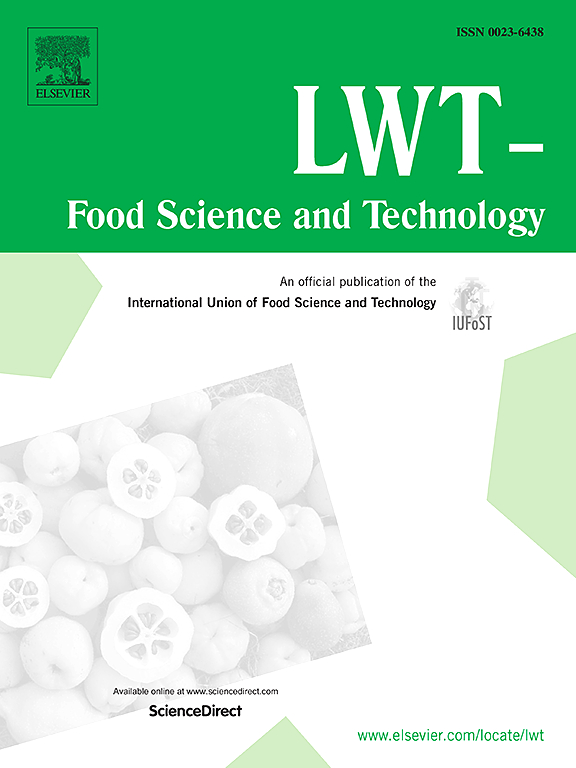SELECT-OLS calibration models for robust fatty acids quantification in various vegetable oils using NIR spectroscopy: A unified approach across hydroxytyrosol supplementation and deep-frying conditions
IF 6
1区 农林科学
Q1 FOOD SCIENCE & TECHNOLOGY
引用次数: 0
Abstract
This study aims to develop a unified, reliable, and cost-effective model for quantifying fatty acids in edible oils to improve nutritional labeling and thermal-oxidation stability. Using near-infrared spectroscopy (NIRS) combined with multivariate calibration, reduced-spectrum regression models were created to identify key fatty acid markers in various oils, including extra virgin (EVOO), virgin (VOO), refined (ROO), and pomace olive oils, as well as sunflower oils. Oils were analyzed before and after deep frying, with or without hydroxytyrosol (HTyr) supplementation. Stepwise decorrelation of the variables (SELECT) improved regression models for seven fatty acids: myristic, palmitic, palmitoleic, stearic, oleic, linoleic, and lignoceric acids, achieving correlation coefficients (R) of 0.96–0.99. SELECT-ordinary least squares (OLS) regression provided highly predictive models, using up to 30 out of 700 wavelengths, with selected predictors ranging from 5 (for linoleic acid) to 30 (for stearic acid), showing adaptability to various spectral patterns. These models enable real-time fatty acid quantification in EVOO, VOO, ROO, and sunflower oils, under different deep-frying conditions (170–210 °C/3–6h), including both HTyr-supplemented and non-supplemented samples. NIRS with optimized variable selection simplifies analysis and reduces costs by replacing gas chromatography, enabling direct analysis without sample preparation. The models showed strong predictive performance, with high leave-one-out (LOO) explained variance (85.81 %–98.16 %), confirming NIRS as a feasible, rapid, non-destructive, and eco-friendly method for quantifying edible oils.
使用近红外光谱对各种植物油中健壮脂肪酸定量的SELECT-OLS校准模型:跨羟基酪醇补充和油炸条件的统一方法
本研究旨在建立一种统一、可靠、经济的食用油脂肪酸定量模型,以提高营养标签和热氧化稳定性。利用近红外光谱(NIRS)结合多变量校准,建立了简化光谱回归模型,以识别各种油中的关键脂肪酸标记,包括特级初榨橄榄油(EVOO)、初榨橄榄油(VOO)、精制橄榄油(ROO)、果渣橄榄油以及葵花籽油。油在油炸前后,添加或不添加羟基酪醇(HTyr)进行分析。变量的逐步去相关(SELECT)改进了7种脂肪酸的回归模型:肉豆蔻酸、棕榈酸、棕榈油酸、硬脂酸、油酸、亚油酸和木质素酸,相关系数(R)为0.96-0.99。选择-普通最小二乘(OLS)回归提供了高度预测模型,使用多达700个波长中的30个,选择的预测因子范围从5(亚油酸)到30(硬脂酸),显示出对各种光谱模式的适应性。这些模型能够在不同的油炸条件下(170-210°C/ 3-6h)实时定量EVOO、VOO、ROO和葵花籽油中的脂肪酸,包括添加htr和未添加htr的样品。NIRS与优化变量选择简化了分析,降低了成本,取代气相色谱,使直接分析无需样品制备。该模型具有较好的预测效果,LOO解释方差(85.81% ~ 98.16%),证明近红外光谱法是一种可行、快速、无损、环保的食用油定量方法。
本文章由计算机程序翻译,如有差异,请以英文原文为准。
求助全文
约1分钟内获得全文
求助全文
来源期刊

LWT - Food Science and Technology
工程技术-食品科技
CiteScore
11.80
自引率
6.70%
发文量
1724
审稿时长
65 days
期刊介绍:
LWT - Food Science and Technology is an international journal that publishes innovative papers in the fields of food chemistry, biochemistry, microbiology, technology and nutrition. The work described should be innovative either in the approach or in the methods used. The significance of the results either for the science community or for the food industry must also be specified. Contributions written in English are welcomed in the form of review articles, short reviews, research papers, and research notes. Papers featuring animal trials and cell cultures are outside the scope of the journal and will not be considered for publication.
 求助内容:
求助内容: 应助结果提醒方式:
应助结果提醒方式:


